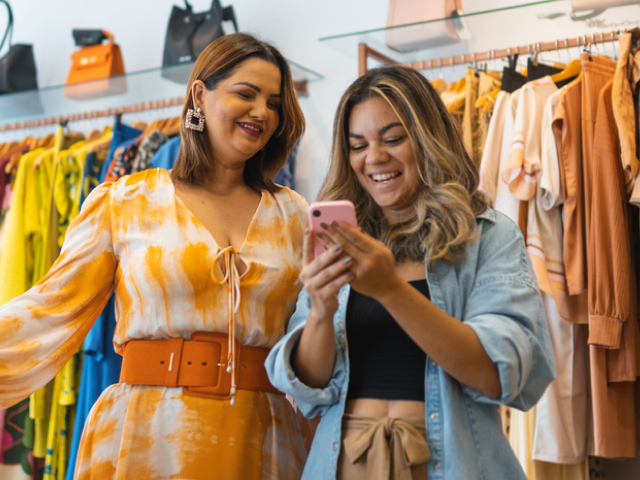Flexible, touchless, and personalized experiences will be central to the customer experience
The store has endured a changed landscape and some stores have become resilient, transforming the way we interact with our favorite brands. The pandemic has been a driving disruptive force to retail, as we’ve witnessed store closures, the emergence of a new customer and the race for online shopping. With the disruption also came a surge of new technologies, such as curbside pickup and appointment booking that have helped retailers pivot and stay connected to loyal customers.
Today’s consumer has dramatically shifted their behaviors, comfort levels and expectations. They now look for more choice and value when they shop and at a level that keeps them feeling safe. Retailers have quickly adapted to provide more convenience, personalization, and agility to match these new demands.
This year, we’ll continue to see the move towards more personal, contactless, and seamless shopping experiences. We’ll also start seeing growth in retail sales with the US retail sales expected to grow 2.3% to $5.630 trillion and the UK retail sales expected to grow by 2.4%. Although we have shifted from in-store to online shopping, the connected store will remain at the core of retail this year. However, the store will need to continuously reinvent itself to deliver more seamless and high-touch customer experiences across multiple channels, maintaining customer relationships and increasing sales.
Trend #1 – Delivery and fulfillment hubs become the norm
With temporary closures, stores will need to reinvent the way they use the physical space to provide a rewarding experience. According to a Deloitte report, more than 50% of consumers reported spending more on convenience to get what they need, often by contactless shopping, on-demand fulfillment, delivery app usage and Buy Online Pickup In Store (BOPIS) adoption. It’s clear that store fulfillment is here to stay and it’s become the preferred form of shopping, ensuring products end up in the hands of customers faster and without hassle.
Retailers will see an increase in fulfillment orders until stores are opened fully. Also, consumers will expect retail stores to provide sustainable seamless experiences in the short and long term. According to Retail TouchPoints, 84% of shoppers are unlikely to shop with a brand again after a poor delivery experience, and 98.1% believe that delivery impacts their brand loyalty.
To maintain a high-level shopping experience, retailers will need to integrate data analytics and store management tools on mobile devices to keep store associates current on inventory availability and fulfillment status. Stores will continue to leverage the in-store space as fulfillment centers to shorten the gap between clicking and collecting purchases.
Trend #2 – Contactless technology cultivates efficiency and peace of mind
The growth in contactless technology is nothing new in retail, however, 2023 will see a stronger push towards creating touchfree and virtual experiences. In response to the pandemic, retailers will provide customers with safer and more convenient shopping alternatives to interact with a store.
Integrated touchfree payments will become the preferred method for consumers to make a purchase. Point of sale payments will go through a transformation in making digital-first payments an option. This will include the rise of digital wallets, QR codes, and contactless cards.
Experiential reality (blend of augmented and virtual reality) and artificial intelligence will provide convenience and safety to customers who wish to receive the in-store experience at home. Customers who prefer to visit stores normally to view large items or view makeup products in real time, can now sample items through virtual change rooms or showrooms.
Trend #3 – Personalized shopping spotlights the customer experience
The previous several years have established that personalization is paramount, and it’ll continue to play a critical role in the customer journey this year. Consumers are looking to engage with brands who personalize their experience. In fact 78% of consumers said they will only engage with offers that have personalized to their previous engagements with the brand.
Customers will continue to expect more from store associates and will rely on them to predict their needs when they visit a brand. They’ll also expect brands to provide the same level of attention they would get in the physical store, now online. Technology will continue to help bring personalization at scale both online and offline, with the ability to provide one-to-one in-person or virtual consultations or fittings.
Retailers will need to increase omnichannel engagement with customers. Arming store associates with customer data they need, like customer preferences and purchase history, will help them drive long-term revenue and strengthen customer connections.
Trend #4 – Omnichannel ecosystems become mandatory
The pandemic created a surge for online shopping. Brands who did not have an ecommerce presence had to quickly build a platform to connect with current customers. Despite a growth in online shopping, the pandemic made consumers more fluid about whether they buy online or offline. In Google’s Smart Shopper Research, 73% of consumers described themselves as channel agnostic (up from 65% before the pandemic). And so, we’ll continue to see the growth in digital transformation enhancing the convergence of online, in-store and social channels. Retailers will continue to develop a robust omnichannel strategy and use data to bridge all channels into one seamless experience.
It’s also clear that customer behavior has shifted in favor of digital and omnichannel experiences during the pandemic. In a recent Applause survey, 71% of customers were more likely to shop with a brand that offers omnichannel shopping options while 68% are currently using omnichannel shopping options more often this year because of the pandemic. With the rise in omnichannel shopping, brands will have to create holistic experiences that build trust and have customers coming back again.
2020 showed us the value in contactless technology, personalized touchpoints and omnichannel platforms. Although we have shifted from in-store to online shopping, the store still remains at the core of the retail experience. We can expect to see a continuation in the evolutionary growth and change of the physical store as it pivots to deliver more seamless and highly personalized customer experiences throughout the entire omnichannel.
Subscribe to our blog today to gain access to the latest updates, trends and insights.


